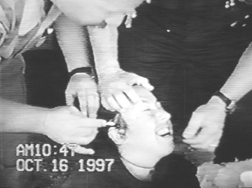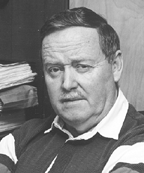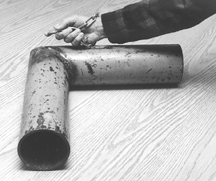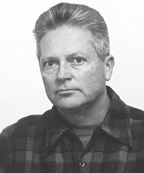

by Judy Hodgson

On Oct. 30 Dan Rather looked sternly into the camera, lifted his eyebrows and said, "In California tonight, an alleged case of police abuse with an unusual twist. Environmentalists are charging that they were assaulted with pepper spray. Police say it was effective crowd control. Whatever it was, the confrontation itself is preserved on videotape. CBS' John Blackstone has the tape and the story."
BLACKSTONE: "For law enforcement in Northern California, the demonstrators have become frustratingly persistent -- young environmentalists, determined to do whatever they can to save the ancient redwoods. But when protesters locked themselves together in a sit-in at the local congressman's office, police and sheriff's deputies found a quick, if controversial way, to break it up."
UNIDENTIFIED WOMAN: "Ow! Ow! Ow!"
BLACKSTONE: "Videotape shot by officers themselves shows an unusual use of the chemical called pepper spray. With a cotton swab, officers applied it directly. Under most guidelines, the debilitating chemical is sprayed from several feet away and used only against violent suspects. It causes painful stinging of the membranes of the eyes, nose and throat; eyelids swell closed. One of the demonstrators was Lisa Sanderson Fox.
FOX: "It's totally out of proportion to what they did to us. I mean, it was torture, and they were just kind of experimenting on us and we ..."
BLACKSTONE: "The police chief of Eureka, Arnold Millsap, insists the demonstrators got what they deserved."
MILLSAP: "They're 'outraged,' to quote one of 'em. Well, be outraged. I don't care."
BLACKSTONE: "For local authorities, this novel use of pepper spray is not viewed as torture; it's seen as efficiency. If it brings the demonstrations to a quick end, it's cost-effective law enforcement.
"The company that manufactures pepper spray includes a warning in its instruction manual: Never spray closer than three feet. That can cause tissue damage. At least once, a sheriff's deputy sprayed directly into the eyes of a demonstrator."
FOX: "It was just intensely painful and we weren't prepared for that."
BLACKSTONE: "The demonstrators plan to sue. It may be up to a jury to determine the line between cost-effective law enforcement and torture.
UNIDENTIFIED WOMAN No. 2: "Leave her alone! Stop it! Stop it!
UNIDENTIFIED WOMAN No. 3: "No!"
BLACKSTONE: "John Blackstone, CBS News, Eureka, California."
Whether CBS or ABC was first with the story the evening of Oct. 30, within hours the video clip was being viewed around the world every half hour on CNN. It showed North Coast law enforcement officers squirting pepper spray into a paper cup, dipping Q-Tips into the liquid and methodically painting the eyelids of four young women, their arms voluntarily locked together in metal pipes, screaming and writhing in pain in the Eureka office of Congressman Frank Riggs.
It was the lead story in major newspapers across the nation the next morning. Before the week was out the heavily edited tape with audio was posted on the Internet and newspaper editorial writers from coast to coast began excoriating local law enforcement for using a chemical weapon against nonviolent protestors.
Condemnation was quick and universal outside of Humboldt County -- even from law enforcement leaders.
Reaction within the community was mixed -- and very polarized -- ranging from "The demonstrators got what they deserved" to "Oh my god, this is Selma in the '60s," referring to civil rights demonstrators in Alabama who were brutally beaten by police.

One week after the media blitz hit, Eureka Police Chief Arnold Millsap sat in his office with tears in his eyes. "I have never been so vilified. I'm a good cop. I don't understand this." On his secretary's desk was a two-inch pile of hate mail. The phone rarely stopped ringing. Counselors had been called in earlier in the week to help office staff cope with the angry reaction from the public.
Millsap said the ironic thing about all this uproar is that he is very much a champion of peaceful assembly and protest. Before he entered law enforcement, he was a mill worker and union organizer.
"I took part in strikes and carried banners. I know what it's like walking up and down the sidewalk," he said.
Since becoming a police officer, Millsap has seen his share of demonstrations.
"During the Vietnam War, we once had 4,000 people at the federal courthouse at 5th and H," he said. When Redwood National Park was expanded, U.S. Congressman Phil Burton, D-San Francisco, held a near-riotous hearing at the Eureka Muni and Millsap was on duty.
"If people want to demonstrate, my job as a peace officer is to facilitate it," he said.
How did this free speech champion become the ultimate officer in charge of police conduct Oct. 16 in Riggs' office?
"People have the right to dissent," he said. "But when they get to 'extra' legal activities, my job is to deal with them. They can say anything they want, they can take political action, as long as it's not through force or violation of other people's rights."
That day, Millsap said, the protesters broke the law and were placed under arrest.
"When you go to arrest someone, do you say, you're under arrest and let them walk off? You can't do that. So you use necessary force to restrain someone and to take them into custody," he said.

"If someone refuses, you have a group of tools and procedures available -- and here's where the difficulty comes in. You can't say, if that person does this, you whack them with a baton or use OC (pepper spray), or use pain compliance. There are 300-400 different tasks an officer needs to know how to do with 30,000-40,000 variables."
That day in Riggs' office, officers had a new technique available, one approved a month earlier and one that had been used in the field twice before against demonstrators: applying pepper spray on a Q-Tip to the eyelids of protesters.

The decision to use pepper spray had been approved by Sheriff Dennis Lewis in mid-September.
"When Dennis (Lewis) first proposed it to me, I said, 'Why do you want to do it that way?'" Millsap told the Journal. "(Lewis) said, 'Because I don't want to get sued for hurting people. I don't like the idea of hurting people.'"
In an interview about a week later, Lewis, too, was still reeling from the national maelstrom of criticism. In contrast to the garrulous EPD chief, Lewis was philosophical and very guarded with his answers.
"The question is, what would you do if I came to your office and disagreed with something you've written. I come and occupy your office and that effectively shuts you down," he said.
"Each circumstance is unique. In one instance, when (Earth First! demonstrators) attached themselves to a truck, we didn't cut the device, we didn't use pepper spray. We had a mechanic disconnect the drive shaft."
Where did the Q-tip application originate?
"It's been around forever. We used it in my basic academy at College of the Redwoods 29 years ago -- only it was mace (tear gas)," Lewis said.
The California Highway Patrol and other police academies also train officers by applying the chemical manually, with a Q-tip on the face under the eye, and in some instances by spraying volunteers according to the manufacturer's guidelines: from a distance of three to 10 feet. The purpose is for officers to experience first hand the effects of the chemical. No training course, however, suggests using the manual application techniques in the normal course of police work.
Lewis said the proposal to swab the eyelids came up about three years ago when he was first elected.
"The idea came up and we looked into it and we came to the conclusion that is was both legal and hopefully effective," he said.
Lewis told The Journal that legal approval came from three attorneys: District Attorney Terry Farmer, County Counsel Tamara Falor and an outside attorney whom Lewis later declined to identify.
A meeting in mid-September where the final decision was made was attended by Lewis, Farmer and county Risk Manager Kim Kerr, according to Lewis and Kerr.
"I had knowledge that they wanted to use pepper spray by using swabbing. I was consulted," Kerr said.
Falor declined to comment "due to attorney-client privilege" and Farmer did not return telephone calls. But in an interview aired Nov. 5 on San Francisco station KRON-TV, the district attorney admitted he was involved in the decision.
"The discussion was that the method was both effective and would result in a decreased likelihood of harm to those involved," Farmer said.
"Ultimately, I gave approval," Lewis said.
With the approval of three attorneys and the county risk manager, Lewis gave the go ahead to his deputies in the field not only to use pepper spray against demonstrators but to apply it manually.
They didn't have to wait long. On Sept. 25 a call came in reporting a demonstration at Pacific Lumber Co. headquarters in Scotia. A colorful crowd of Earth First! demonstrators gathered outside chanting, singing and making speeches demanding that 60,000 acres surrounding the Headwaters Forest be preserved, not just the 7,500 acres in the bill approved by Congress and signed by President Clinton last month. Two demonstrators were perched on the roof and seven more -- each with a 25-pound v-shaped pipe -- entered the lobby and chained themselves together.
The 50-minute police tape reveals a human drama unfolding with both sides -- the protesters and the law -- fully aware of the camera clicking away. The seven sing, "Keep your eyes on the prize" and began to chant, "60,000 acres, no compromise."
At 10:03 a.m. an officer orders the group to disperse and gives them five minutes to think about it. One protester says, "I have asthma." One officer is heard on the tape ominously warning, "You've got an education coming."
When the officers began to swab the chemical on the eyelids of the protesters, three release before being swabbed, breaking up the circle of seven. Two pair remained hooked together and refuse to release even after being swabbed a second time. After five more minutes elapse, officers began to apply water to flush the chemical from their eyes.
Stretchers are brought in and the first pair -- two relatively lightweight women -- are carried outside where they finally release from the pipes and are handcuffed. The final pair, a heavier woman and a man, are carried out. Officers place an asbestos blanket over and around the protesters, then use a metal grinder to chip away at the weld on the pipe. At one point water is poured over the pipe to cool it off. After about four and a half minutes, a chisel is used to pry open the joint. The fingers of the protestors are clearly visible. The chain inside is cut, freeing the final two, and all seven are transported to jail along with the two protesters from the roof.
Tear gas -- and its more modern chemical cousin, pepper spray -- has long been a tool of law enforcement for dispersing a riot or flushing out criminals holed up in a building. But its use directly on demonstrators was new, occurring for the second time Oct. 3 at Bear Creek, also on PL land. Two men claim they were swabbed, sprayed at close range and eventually cut out of their arm-locking devices.
That incident, too, was filmed by sheriff's deputies. However, since charges against the men were later dropped, that tape has not been released to their attorney.
On Oct. 16 at Riggs' Eureka office -- the third pepper spray incident -- Earth First! brought along its own videographer. The result is a two-minute tape showing a highly choreographed operation.
A neatly dressed young couple, identified as "protester support," stands by observing as several men in dark clothes (one in a ski mask) wheel in and drop a stump. Four women quickly enter, say good morning, sit around the stump and link arms inside the heavy pipes. Other protesters scatter sawdust.
One Riggs staff member is on the phone. Another enters the room, sets off an alarm and crosses in front of the camera to block the exit door in the lobby. She is heard saying, "No one is leaving." All "protester support" exit by another door leaving the four protesters behind and say, "Good luck. We love you."
The action picks up again on the official police video. Officers enter, plead with the women to release, issue warnings and prepare the pepper spray. One woman says, "It's not going to look good in court. You have other options. ... This is a new thing you are doing to the American public."
Eventually all women are swabbed. One of them -- Jennifer Schneider, who was also arrested at Pacific Lumber -- is swabbed seven times, back and forth, across one eyelid.
One by one, the protesters begin to release. When only one pair remains linked, a woman is sprayed directly into the eyes from about two inches. All are removed to the outer office and first aid is applied.
Some who have studied the tapes say if not for the use of pepper spray, the tapes could be used as a modern police training film. With a few exceptions, the officers are polite, patient and resistant to the verbal baiting of the protesters.
Mark Harris of Arcata, attorney for the protesters, strongly disagrees.
"At least in the Rodney King thing, you have hot rage. (Police officers) are angry. You can see it, you can smell it, you can taste it," Harris said. "In this case, the thing that is so fascinating to America -- and the world -- is the chilling methodology of no emotion.
"And the blue line, not breaking ranks, is part of the problem," Harris said. "There were 10 to 15 men (officers) in each instance -- Scotia and in Riggs' office -- in a demonstration of force that completely shocked the conscience of this nation," Harris said. "They didn't stop. They didn't to my knowledge make any kind of internal complaint.
"I expect those people to say, 'I'm not going to do this' -- and to report it."
Harris knew pepper spray was used on the demonstrators after each incident (it was reported in the Times-Standard) but it wasn't until Tuesday, Oct. 28, that the district attorney's office turned over the tapes to him. Two days later he was in San Francisco, releasing the tapes to the national media and asking for a temporary injunction in federal court to suspend the use of pepper spray against demonstrators.
The judge denied the motion, saying it was not up to the court to second-guess officers in the field in the use of an approved use-of-force device.
Round one went to Humboldt County and the city of Eureka and their attorneys received a welcome home by Sheriff Lewis and others when their plane landed at the county airport Nov. 14. But other legal battles have only just begun.
Harris is defending a total of four protesters -- ones who have actually been charged -- on criminal charges stemming from the three incidents. He said he would "most definitely" be asking for a change in venue should those cases ever reach a jury trial.
In the separate civil rights lawsuit, Harris and Colorado attorney Macon Cowles represent nine plaintiffs. They allege their clients were subjected to unreasonable use of force and excessive detention and were denied their basic rights of free speech, association and to petition government under the 1st, 4th and 14th amendments to the Constitution. That case will probably go to trial next summer in San Francisco.
Although some people oppose any use of pepper spray, Harris said it is "a legitimate use of force" on violent offenders and he "completely supports good cops." But since he came to Humboldt County in 1989, he said there has been a pattern of increased harassment of protesters and other trends he calls "disturbing."
He was the attorney who filed suit against the county in 1990 -- after Redwood Summer demonstrations --when four protesters were arrested and had their heads forcibly shaved in the county jail. The American Civil Liberties Union joined in the case and the county settled for $100,000 to avoid further publicity and a trial.
"That was my first experience with Humboldt County law enforcement," he said.
"This case was also probably a shock ... (but) in between those two cases my suggestion is just because you don't have footage of it doesn't mean something didn't happen.
"Harassment ... takes the form of everything from the liberal use of very severe pain compliance holds on nonviolent demonstrators to excessive detention pretrial -- putting kids in jail a long time without even an arraignment, dragging them through pretrials only to drop their case, chalking up a bunch of charges which you ultimately dismiss, using our judicial system short of trial to hurt people ... because they are politically opposed to your point of view."
Harris said many cases go unlitigated because "the only witnesses are the persons facing criminal charges and law enforcement.
"Civil disobedience on the North Coast is very different than civil disobedience on college campuses or in urban area. There's no one else to see."
Harris also pointed to an increase in law enforcement willingness to declare an "unlawful assembly."
"This is often the first thing out of their mouths," Harris said of law enforcement. "But to make that call, you have to show that there is some imminent peril, some danger to the public or to property or a riot about to occur.
"We need to compare the amount of force used in all its manifestations including going to jail and compare that to the harm caused. That is the essence of a 4th amendment analysis," he said.
As to his clients' veracity, Harris said that signed statements, called declarations, were made in advance of the release of the controversial tapes and will be used in the civil suit to support his clients' version of events.
"There is another thing that falls into they-just-don't-get-it department," Harris said. "The DA amended the complaint to add a charge of vandalism (at Riggs' office). I didn't know what it was for until I got a dry cleaning bill. One of the women who had been sprayed with pepper spray had urinated on herself. The DA's response is to add an additional charge of $97 for dry cleaning (the carpet).
"After this national exposure, do I think this place is worse than some urban environment? With that attitude, yes.
"I think it's time for a housecleaning."
By the end of November a media war had broken out on television. The Sierra Club produced a national appeal for funds to support efforts to save the Headwaters Forest and other environmental causes. In Humboldt County, an advertising agency solicited funds to produce a we-support-law-enforcement ad which ran on local stations. Both used clips from the police video.
Petitions were being circulated throughout the county calling for the resignations of Sheriff Lewis and Chief Millsap. But there were also petitions of support and Millsap has the unanimous backing of the Eureka City Council.
Arcata Police Chief Mel Brown was in Arizona visiting his son Oct. 30 when the video came on national television.
"Pepper spray is always an option. Force is always an option," he said. "I haven't seen the whole tape, but I don't approve of any kind of force on nonviolent people as long as they're not resisting." He said an example of resisting arrest would be physically pulling away from a police officer.
So what would his response have been in Scotia or Eureka?
"There's no one-size-fits-all answer," Brown said, but using pepper spray in those instances "was not appropriate."
"We have lots of ways (to overcome the resistance of a suspect being taken into custody). Are we dealing with a 220-pound wrestler or a 90-year-old grandmother?"